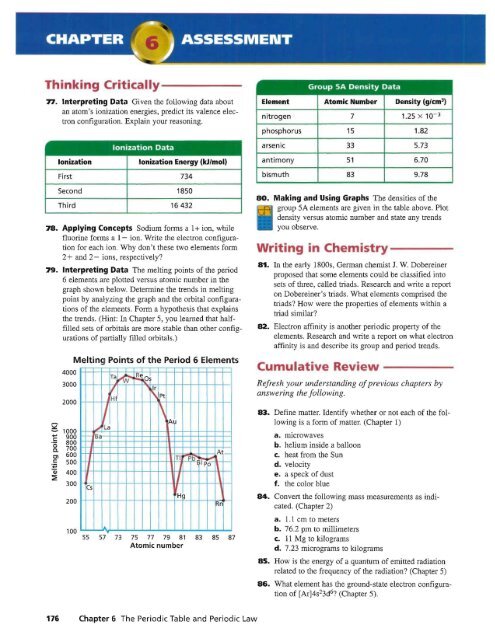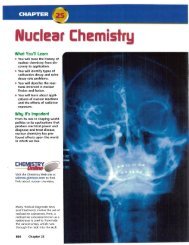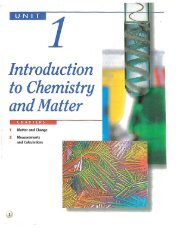Chapter 6
Chapter 6
Chapter 6
You also want an ePaper? Increase the reach of your titles
YUMPU automatically turns print PDFs into web optimized ePapers that Google loves.
- ·nkl 9 Critic II,Y-----<br />
77. Interpreting Data Gi ven the following data about<br />
an atom's ionization energies, predict its valence electron<br />
configuration. Explain your reasoning.<br />
Ionization<br />
Ionization Data<br />
Ionization Energy (kJ/mot)<br />
First 734<br />
-<br />
Group SA Density Data<br />
Element Atomic Number Density (g/cm 3 )<br />
nitrogen 7 1.25 X 10- 3<br />
phosphorus 15 1.82<br />
arsenic 33 5.73<br />
antimony 51 6.70<br />
bismuth 83 9.78<br />
Second 1850<br />
Third 16432<br />
I<br />
78. Applying Concepts Sodium forms a 1+ ion, while<br />
fluorine forms a 1- ion. Write the electron configuration<br />
for each ion. Why don't these two elements form<br />
2+ and 2- ions, respectively<br />
79. Interpreting Data The melting points of the period<br />
6 elements are plotted versus atomic number in the<br />
graph shown below. Determine the trends in melting<br />
point by analyzing the graph and the orbital configurations<br />
of the elements. Form a hypothesis that explains<br />
the trends. (Hint: In <strong>Chapter</strong> 5, you learned that halffilled<br />
sets of orbitals are more stable than other configurations<br />
of partially filled orbitals.)<br />
4000<br />
3000<br />
2000<br />
...... Q'<br />
1000<br />
t: 900<br />
'0 800<br />
c.. 700<br />
Cl 600<br />
t: 500<br />
'+:;<br />
Qi 400<br />
:2<br />
300<br />
200<br />
100<br />
Melting Points of the Period 6 Elements<br />
/<br />
Jife-<br />
-l-<br />
I<br />
..J La<br />
- Ba<br />
T" ..... ReOs<br />
'\<br />
~<br />
Pt<br />
\<br />
Al,l<br />
TI<br />
1- P<br />
J ~IPO 1\<br />
II<br />
At_<br />
CS ~ Hg<br />
Ri~-<br />
I....<br />
55 57 73 75 77 79 81 83 85 87<br />
Atomic number<br />
I<br />
80. Making and Using Graphs The densities of the<br />
group 5A elements are given in the table above. Plot<br />
density versus atomic number and state any trends<br />
you observe.<br />
Wrii 9 -n Chern stry----<br />
81. In the early 1800s, German chemist J. W. Dobereiner<br />
proposed that some elements could be classified into<br />
sets of three, called triads, Research and write a report<br />
on Dobereiner's triads, What elements comprised the<br />
triads How were the properties of elements within a<br />
triad similar<br />
82. Electron affinity is another periodic property of the<br />
elements. Research and write a report on what electron<br />
affinity is and describe its group and period trends.<br />
Cum latlve Rev·ew<br />
Refresh your understanding ofprevious chapters by<br />
answering the following.<br />
8:1. Define matter. Identify whether or not each of the following<br />
is a form of matter. (<strong>Chapter</strong> 1)<br />
a. microwaves<br />
b. helium inside a balloon<br />
c. heat from the Sun<br />
d. velocity<br />
e. a speck of dust<br />
f. the color blue<br />
84. Convert the following mass measurements as indicated.<br />
(<strong>Chapter</strong> 2)<br />
a. 1.1 cm to meters<br />
b. 76.2 pm to millimeters<br />
c. 11 Mg to kilograms<br />
d. 7.23 micrograms to kilograms<br />
85. How is the energy of a quantum of emitted radiation<br />
related to the frequency of the radiation (<strong>Chapter</strong> 5)<br />
86. What element has the ground-state electron configuration<br />
of [Ar]4s 2 3d 6 (<strong>Chapter</strong> 5).<br />
176 <strong>Chapter</strong> 6 The Periodic Table and Periodic law












